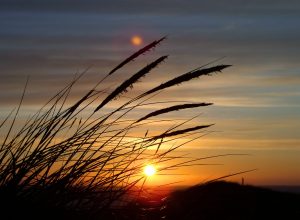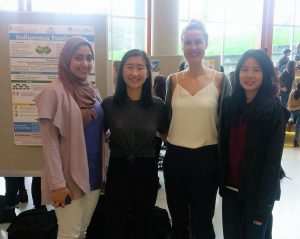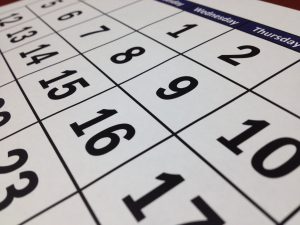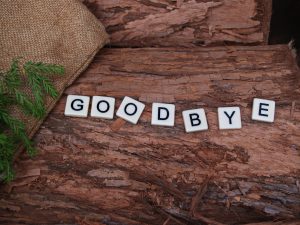“Saying goodbye doesn’t mean anything. It’s the time we spent together that matters.” -Trey Parker

Welcome to our last blog post! We can’t believe that our project is already coming to an end; it felt like just yesterday that we first walked into LFS 350, full of curiosity and uncertainty about the upcoming months! But here we are, at the end of our journey, with a last update on how our project has progressed to date.
Update on the past few weeks…
As we anticipated, the past few weeks since our last blog post have been quite hectic. We received feedback for our AER outlines, and took into account all of the valuable suggestions to create focused and improved papers relating to food justice. We learned about the elements that make up effective infographs, and we had a chance to demonstrate our learning by creating an infograph of our own for our Indigenous Foodscapes project. We also attended the public presentation session in the AMS Nest, where two of our members (Arooj and Vinci) did an amazing job at condensing our three-month-long project into a short pitch to share our learning with the TAs, UBC students, and with the amazing community partners that took the time out of their busy schedules to check out the presentations. It was very helpful that our own community partners, Sam and Lori, came to support us at the beginning of the presentation session, leaving us feeling prepared and comfortable for the rest of the presentations.

What?
Although our work with the Indigenous Foodscapes project is nearing an end, the project itself is still in the initial planning stages; it was expected that there would be quite a bit of uncertainty throughout the process. While the second meeting with our community partners did give us a clearer image of what the finished report templates should look like (more info on that below!), there were still information gaps that we were lacking. For instance, we all agreed during the second meeting that inserting images of the garden sites and labelling areas where new plants could be added would be a great visual way to let the Vancouver School Board understand what sort of Indigenous Foodscapes the schools were looking for. However, it wasn’t until we actually sat down to look at the physical report template that we realized we didn’t have clear photos of each garden site individually, and even though we had a large list of suggestions that Lori had provided for us, we did not have adequate information about where specific plants could be implemented. Also, since we had not discussed our own (LFS 350) timelines in this project with the teachers, we were unable to receive a finalized list of what plants the teachers actually wanted to implement to incorporate into our infographs. This was mainly due to scheduling conflicts, as the elementary schools were on spring break for the past 2 weeks, during which our infographs were created and presented.

So what?
Because we were missing some information for the report template, some of our group members went back to the schools to take clearer photos of the garden sites. As for the plant lists, we were notified that the teachers would have their meeting for finalizing plant wishlists after spring break, so we just drew from suggestions to present a list of possible plant additions in our infograph. The lack of communication about our project timelines could have been due to a lack of clarity in what we understood our role to be, which also ended up impacting deadlines because of the two week spring break that the elementary schools had. We had focused more on simply documenting the conversations happening between our community partner and the schools, while neglecting to mention that our participation in the project through LFS 350 had deadlines in which we would need responses from the schools as well.
We learned that projects involving many different participants require careful pre-planning to ensure things work smoothly. Although collaborations that involve different parties may create more uncertainty and chances of hitting bumps in the road, the results of those combined efforts often lead to even greater results than working alone; this is explained in an article by Bang, Carol, & Lee (2014) in which they describe learning from multiple perspectives, rather than just a single view, as leading to an even more powerful learning. We observed this benefit of collaboration at one of the schools we visited, in which teachers brought in ideas about wanting to implement mason bee nests by their garden; this idea might not have been brought up had there not been a walking tour to discuss the teachers’ own ideas and visions for the garden, along with suggestions from Lori. This also connects to the themes mentioned by Mathie & Cunningham (2003), where communities are the most important players in identifying their own assets and needs for improvement. We observed this firsthand as a teacher at Florence Nightingale elementary pointed out the existence of their old compost bins, and wanted to restart their composting program again to plant potatoes; they already had their ideas in mind, and just needed Lori for her expertise and the collaboration with Farm-to-School to start putting their vision into action.

Now what?
Moving forward, we will continue working with the information that we do have, in order to fill out a report template to include potential plans and suggestions that the schools might want to add into their gardens. We will also have to accept the fact that we may not be able to fill all the information gaps present on the template document, simply because the template was created in a way to categorize the data obtained from all 8 elementary schools, which all have diverse garden situations. As mentioned by Lee Shulman (2005), “Without a certain amount of anxiety and risk, there’s a limit to how much learning occurs” (p.18); this is an important reminder that the uncertainty we experienced throughout our project was actually a necessary step, and that issues and discomfort guide us in our learning process. The purpose of our work on this pilot project was to bring the clarity and quantitative/ qualitative data to Farm to School so that funding could be allocated to schools; we also had the opportunity to “pave our own path” in the sense that we were able to decide as a group, based on our gathered data, the type of final report we would be creating. With this experience as evidence, we hope to bring this renewed attitude of embracing the unknown to our future projects and collaborations.

Last few remaining objectives…
Now, the only remaining items we still have yet to check off for the next 2 weeks are 1) the completed report templates on Florence Nightingale and Dr. AR Lord elementary schools for our community partner, and 2) the final community project report. The report template we will be preparing for Farm to School incorporates both qualitative data (ex. learning opportunities, suggested garden site usages, etc.) and quantitative data (ex. number of plant beds, plant species, etc.), which we collected during the walking tours with Lori and on a separate trip to take more detailed photos of the gardening spaces; our work now is to label and organize all that information into the report template. The final community project report will be focused on describing our project/journey (methods, results, discussion, etc.) and drawing from our personal experiences throughout the experience. After that, our objectives for LFS 350 will officially be complete.

Thank you… ❤
We wanted to say a big thank you to everyone that has followed us on this journey through our blog! Also special thanks to Sam, Lori, Robert, and the rest of the team for allowing us LFS students to help out with such an amazing project.

References:
Bang, D. M., Carol D., & Lee, M. (2014). Point of View Affects How Science Is Done. Scientific American. Retrieved from http://www.scientificamerican.com/article/point-of-view-affects-how-science-is-done/
Mathie, A., & Cunningham, G. (2003). From clients to citizens: Asset-based Community Development as a strategy for community-driven development. Development in Practice, 13(5), 474–486. doi: 10.1080/0961452032000125857
Shulman, L. S. (2005). Pedagogies of uncertainty. Liberal Education, 91(2), 18–25. Retrieved from http://files.eric.ed.gov/fulltext/EJ697350.pdf